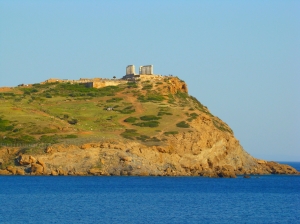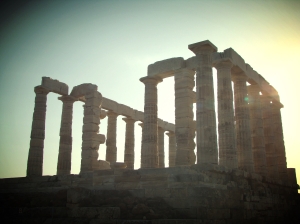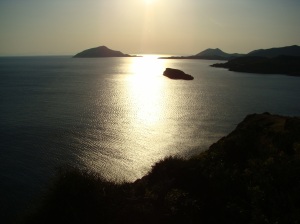Cape Sounion: where the story begins #TheUndeadMustDie #ComingSoon
I thought you might want to learn more about Cape Sounion and the amazing legend to which it's been linked: the myth of Theseus and Minotaur.
So, I'm borrowing the relevant Chapter of my travel guide book 'City Break In Athens' and it's posted below.
Before you start reading, please keep in mind that:
- If you want to learn more about the historical sites and conspiracy theories from which I drawn inspiration for the storyline of 'The Undead Must Die', you are welcome to follow my Pinterest board of the same name.
- December the 28th has been set as the official release date of 'The Undead Must Die - The Order of the Black Rose'. If you want to keep posted of special offers and free download days, please sign up for my newsletter (I won't spam your inbox, that's a promise): Penny's Newsletter.
CAPE SOUNION
Cape Sounion is surrounded on three sides by Aegean Sea which was named after Aegeus, the king of Athens, who jumped into the sea and drowned after believing his son was dead.
Cape Sounion is noted as the site of the ruins of an ancient Greek temple of Poseidon, the god of the sea in classical mythology. If you look carefully you'll notice on one of the columns the deeply engraved name of English Romantic poet Lord Byron (1788-1824). To be honest, there is no direct evidence that the inscription was made by Byron himself, although Byron mentions Sounion in his poem Isles of Greece.
Sounion is a popular half day trip from Athens. The road from Varkiza to Sounion is perhaps one of the most beautiful in Attica, despite the fact that it is a winding road. Sunset at Cape Sounion is one of the most famous in Greece and you can enjoy the view while having a refreshment at the nearby cafe that stands alone in the area.
- The Story of Aegeus and Theseus
Still without a male heir after two marriages (to Meta and Chalciope), Aegeus asked the oracle at Delphi for advice. "Do not loosen the bulging mouth of the wineskin until you have reached the height of Athens, lest you die of grief," was the prophecy, but Aegeus understand nothing.
Disappointed, he decided to visit Troezen and ask the famous King Pittheus for his wisdom. Pittheus understood the prophecy and introduced Aegeus to his daughter, Aethra.
On their wedding night, Aethra waded to the island of Sphairia (aka Calauria) and bedded Poseidon, god of the sea and earthquakes, and she became pregnant.
Soon after, Aegeus decided to return to Athens. Before leaving, he buried his sandals and sword under a huge rock. He told Aethra that when their son grew up he should move the rock and take the tokens for himself as evidence of his parentage.
In Troezen, Theseus grew up and became a brave young man. He managed to move the rock and took his father's weapons. His mother then told him the truth about his father's identity. Theseus decided to go to Athens to claim his birthright. He defeated a great many bandits along the way and when he arrived, he did not reveal his true identity.
He was welcomed by Aegeus who meanwhile had found a new wife. That was Medea, infamous for murdering the two children she had by her marriage to Jason. Aegeus and Medea had one son called Medus. Determined to preserve her own son's inheritance, Medea convinced her husband that Theseus was a threat. Medea tried to poison Theseus but just in time, Aegeus recognized the sandals, shield, and sword, and knocked the poisoned wine cup from Theseus's hand. Father and son became reunited, and Medea fled to her homeland Colchis in Asia.
- The Story of Minotaurus
Androgeus, son of King Minos of Crete, travelled to Athens to take part in the Pan-Athenian games which were held there every four years. Strong and skilful he was, he soon became a crowd favorite, much to the resentment of the Pallantides, who assassinated him.
When King Minos heard of the devastating news he ordered the Cretan fleet to set sail for Athens. Minos asked Aegeus for his son's assassins, or the town would not be spared. Not being able to discover the assassins’ identity, King Aegeus surrendered the whole town to Minos' mercy. After King Minos’ demand at the end of every Great Year (seven solar years), seven of the most courageous youths and the seven of the most beautiful maidens would be sent as tribute to Minotaurus, never to be seen again.
After he was reunited with his father, Theseus volunteered to slay the monster to stop this horror. He replaced one of the young men and set off with a black sail. Upon his departure, Aegeus told Theseus to put up white sails when he returned if he was successful in killing the Minotaur.
Theseus killed the Minotaur and with the help of Ariadne, King Minos' daughter, he managed to escape. Ariadne gave him a ball of thread so he could find his way out of the Labyrinth.
On the way back Theseus forgot to put up the white sails instead of the black ones. When Aegeus saw the black sails coming, he jumped into the sea and drowned, mistaken in his belief that his son was dead. Henceforth, this sea was known as the Aegean Sea.




Comments